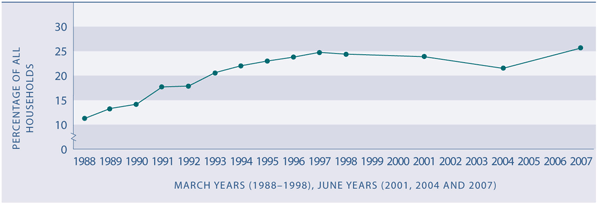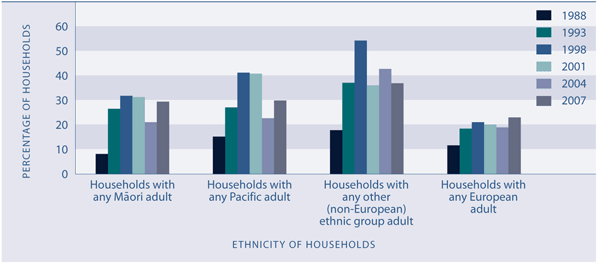Housing affordability
Definition
The proportion of households and the proportion of people within households spending more than 30 percent of their disposable income on housing.
Relevance
Affordable housing is important for people’s wellbeing. For lower-income households especially, high housing costs relative to income are often associated with severe financial difficulty, and can leave households with insufficient income to meet other basic needs such as food, clothing, transport, medical care and education. High outgoings-to-income ratios are not as critical for higherincome households, as there is still sufficient income left for basic needs.
Current level and trends
In 2007, 26 percent of New Zealand households spent more than 30 percent of their disposable income on housing costs, an increase from 21 percent in 2004.
Since the late-1980s, there has been a substantial increase in the proportion of households spending more than 30 percent of their income on housing. Between 1988 and 1997, the proportion rose from 11 percent to 25 percent of households, before levelling off at 24 percent in 1998 and 2001.
Figure EC4.1 Proportion of households with housing cost outgoings-to-income ratio greater than 30 percent, 1988–1998, 2001, 2004 and 2007

Source: Derived from Statistics New Zealand’s Household Economic Survey (1988–2007), by the Ministry of Social Development
Note: Since 1998, the Household Economic Survey has been conducted on a three-yearly basis, rather than annually
There are other measures of housing affordability, which focus on the ability of people to purchase a house and meet the subsequent mortgage repayments. These show a slight improvement in housing affordability between 2007 and 2008.64
Socio-Economic differences
High housing costs relative to household income are of more concern for low-income households. The proportion of households in the lowest 20 percent (lowest quintile) of the equivalised household income distribution spending more than 30 percent of their income on housing rose from 16 percent in 1988 to a peak of 48 percent in 1994. The rate levelled off at 41–42 percent over the period 1996–2001, then fell to 34 percent in 2004 and 33 percent in 2007. While the change since 2001 represents a substantial improvement, the proportion of low-income households spending more than 30 percent of their income on housing was still twice as high in 2007 as it was in 1988.
Households in the lowest income quintile were the only income group to have an improvement in housing affordability from 2004 to 2007. In each of the other four quintiles housing affordability deteriorated. For example, in the third (middle) quintile the proportion of households spending more than 30 percent of their income on housing rose from 21 percent in 2004 to 29 percent in 2007, a higher level than at any other time since 1988.
Age and sex differences
In 2007, 32 percent of children under 18 years lived in households with housing costs exceeding 30 percent of their disposable income, an increase from 26 percent in 2004. There was a similar increase for the 25–44 years age group, many of whom are parents living with children. These changes reflect the increase in the proportion of households spending more than 30 percent of their income on housing in the second and third income quintiles.
In 2007, females aged 15 years and over (25 percent) were slightly more likely than males in the same age group (22 percent) to be living in households spending more than 30 percent of their income on housing.
Table EC4.1 Proportion (%) of the population in households with housing cost outgoings-to-income ratio greater than 30 percent, selected years, 1988–2007
| |
1988 |
1993 |
1998 |
2001 |
2004 |
2007 |
| Total population |
10.6 |
20.6 |
24.9 |
24.1 |
21.3 |
26.0 |
| Population aged 15 and over |
9.9 |
19.0 |
21.9 |
20.9 |
19.7 |
23.6 |
| Males aged 15 and over |
10.3 |
18.8 |
21.0 |
19.9 |
20.0 |
22.2 |
| Females aged 15 and over |
9.5 |
19.3 |
22.7 |
21.9 |
19.5 |
25.1 |
| Age groups |
| Under 18 years |
11.9 |
25.6 |
33.1 |
31.8 |
26.4 |
31.7 |
| 18–24 years |
12.4 |
24.6 |
26.3 |
28.6 |
28.4 |
28.9 |
| 25–44 years |
14.7 |
26.3 |
31.1 |
28.3 |
25.0 |
32.8 |
| 45–64 years |
5.0 |
12.3 |
13.8 |
15.6 |
15.2 |
19.0 |
| 65 years and over |
3.2 |
4.0 |
7.1 |
7.1 |
5.8 |
9.1 |
Source: Derived from Statistics New Zealand’s Household Economic Survey (1988–2007), by the Ministry of Social Development
Note: Data is for March years in 1988, 1993 and 1998 and June years in 2001, 2004 and 2007
Ethnic differences
From 2004 to 2007, there was an increase in the proportion of households with at least one European, Māori or Pacific adult spending more than 30 percent of their disposable income on housing. This is consistent with the the worsening of housing affordability across the top four quintiles.65 Households with housing costs in excess of 30 percent of income are more common when they have at least one non-European adult. For households with at least one Māori adult, the proportion increased from 8 percent in 1988 to a peak of 36 percent in 1997, falling to 21 percent in 2004, then rising to 29 percent in 2007, close to the 2001 level (31 percent). For households with at least one Pacific adult, the proportion increased from 15 percent in 1988 to 48 percent in 1997, then fell to 23 percent in 2004 and then rose to 30 percent in 2007.
Figure EC4.2 Proportion of households with housing cost outgoings-to-income ratio greater than 30 percent, by ethnic group, selected years, 1988–2007

Source: Derived from Statistics New Zealand's Household Economic Survey (1988–2007), by the Ministry of Social Development
Notes: (1) Data is for March years in 1988, 1993 and 1998 and June years in 2001, 2004 and 2007 (2) Household ethnicity is defined
by the presence, within the household, of an adult of a particular ethnic group
|


